The iPhone 7 and iPhone 7 Plus Review: Iterating on a Flagship
by Joshua Ho & Brandon Chester on October 10, 2016 8:00 AM EST- Posted in
- Smartphones
- Apple
- Mobile
- iOS
- iOS 10
- iPhone 7
- iPhone 7 Plus
Battery Life
As-is, one of the most important factors for upgrading a smartphone remains battery life, due to a combination of inherent demand for a phone that can last 2-3 days of use and applications that demand enormous amounts of performance over long periods of time. Apps like WeChat are fairly notorious for holding wakelocks on Android and never really stopping background resource usage so there’s also an element of OS optimization that goes with keeping real-world in battery life up to expectations.
In order to test these things, we’ve spent the past year developing and validating a new web browsing battery life test which updates the sites used and introduces a scrolling component which attempts to better model how a number of tasks are not simply race to sleep and contain a steady-state component. We’ve also updated our rundown tests to better reflect reality and maintain appropriate loads as some devices with high-end SoCs and low display resolution were outpacing our testing. As always, all displays are set to 200 nits with location and other background services disabled to reach a useful relative comparison.

Looking at our WiFi web browsing test, it’s genuinely ridiculous how well the iPhone 7 and 7 Plus perform in this test. The iPhone 7 Plus is definitely down on battery life compared to the Galaxy S7 Edge, but it’s within 5% despite using a battery that’s almost 20% smaller. The iPhone 7 is actually comparable in battery life to the iPhone 7 Plus, and is significantly above the Galaxy S7 with Exynos 8890. Of course, the iPhone 7 has a significantly lower resolution display and a smaller battery, but the nature of smartphone design is that larger devices will generally have better battery life because the board area needed remains mostly constant while the amount of area for battery increases. The iPhone 7 has significantly improved in battery life here, likely due to a combination of A10 Fusion's power optimizations – particularly the small CPU cores – and the removal of the headphone jack, which teardown photos show to have been partially replaced with the battery. However if you do the math efficiency sees a relatively minor uplift.
One other interesting point is that Brandon accidentally ran the battery test on his iPhone 7 with a Safari Content Blocker enabled, which blocked all the ads on the sites that the test visits. In doing so, battery life rose from the normal result of 9.22 hours to 10.03 hours, demonstrating how the increased workload and long-running network requests from ads and trackers really impacts a smartphone's battery life. It's also worth noting that our test constantly cycles through pages, so if you spend a lot of time on a single page with ads you could see an even greater difference.
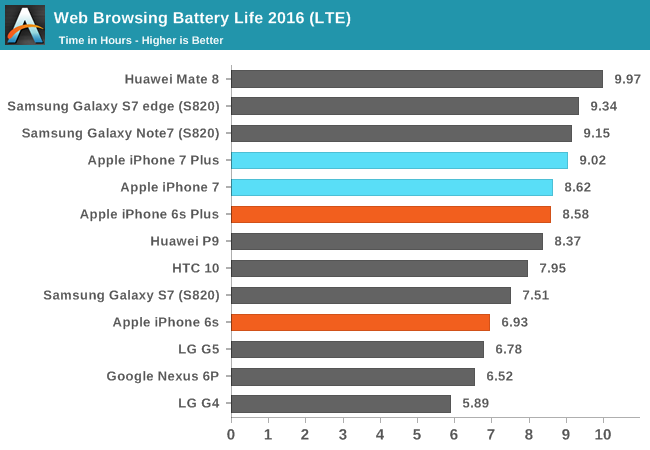
Moving on to LTE battery life the iPhone 7 and 7 Plus both slip a bit, but remain impressive. I suspect that the 20nm Qualcomm modem here is not well-equipped to handle the endless stream of ads that is increasingly a part of most websites. As ads tend to stream in incredibly slowly, the standby power of the modem is a significant factor. Snapdragon 820 devices don’t see nearly the impact here that the iPhone 7 and 7 Plus as their modem is on 14LPP rather than 20SoC. The iPhone 7 remains above the S820 Galaxy S7, but the iPhone 7 Plus is fairly comparable to the iPhone 6s Plus in battery life on LTE.

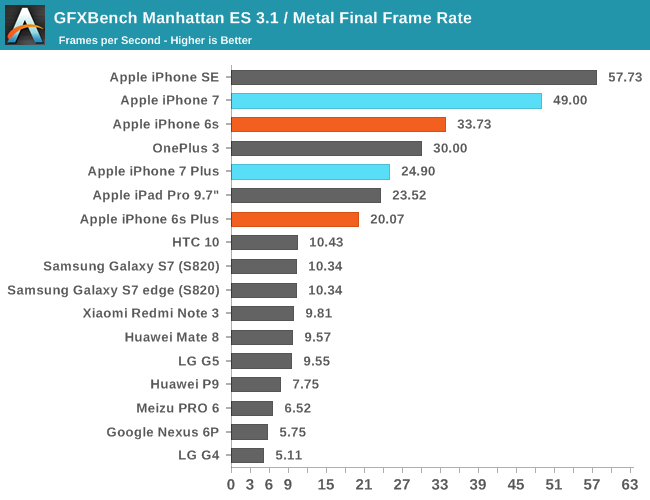
Moving past the web browsing test we use we can take a look at how the iPhone 7 Plus throttles. Unfortunately Basemark OS II was basically broken in this regard for the CPU rundown test so we can only look at how it behaves on Manhattan 3.1, but it's interesting to see how the GPU performance drops about 40% for the iPhone 7 Plus while the iPhone 7 throttles around 20%, because even Manhattan 3.1 is pegged to vsync which means that the GPU can spend much more time idling once a given frame is rendered. It's probably not a surprise here but the iPhone 7 just doesn't last very long here because battery life is strongly SoC-bound. If you attempted to plot battery life as a function of overall SoC utilization, it's entirely possible that the iPhone 7 might last longer than the 7 Plus at the lower bound for utilization, but as soon as you go past web browsing and similarly "light" tasks the 7 Plus and most phablets are going to strongly outperform such a small phone. Here the larger battery helps to get the iPhone 7 Plus nearly another hour of battery life when the SoC is under full, continuous load.
Charge Time
As usual, while battery life is the salient characteristic that determines overall mobility, it’s important to not ignore charge time as there are a number of edge cases where charging has a significant impact on overall mobility. In order to test this we use power measurements at the wall and measure the time it takes from the moment that the charger is plugged in to the moment that it falls below a pre-determined draw from the wall. While this isn’t perfect due to varying levels of DC conversion efficiency and different methods of trickle charging, this method provides at least a reasonable approximation of how long it will take to charge a device.
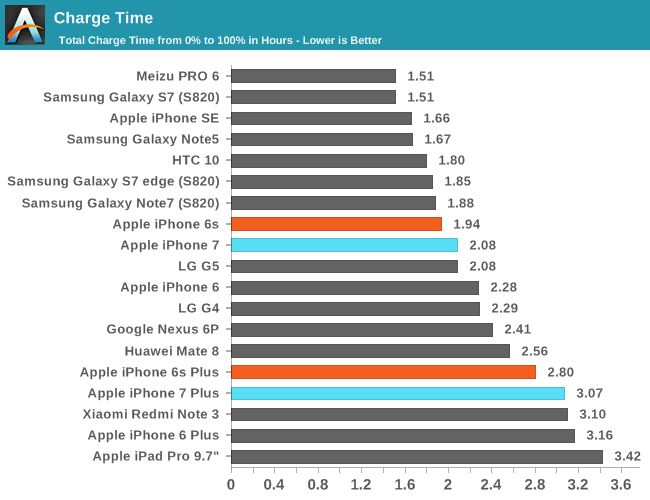
In the case of the iPhone 7 and 7 Plus, Apple continues to ship their standard 5W chargers for US variants. Looking at the results, it’s probably obvious that at least in the case of the iPhone 7 Plus, there is a very real need for Apple to start shipping something with faster charging, as the standard 5W charger takes a full hour longer than most of its competition to charge to 100%. Even the iPhone 7 could use a higher power charger here as using the device while it is charging will significantly impact the charging rate as the charger cannot supply enough power to the board while also charging the battery. And in the case of both phones, the lack of a high power charger doesn't just draw out the total charge time, but it also precludes rapid charging (partially charging a depleted phone very quickly) as well.
It would really be prudent for Apple to start to transitioning to higher power AC adapters at this point. This doesn’t take away from how impressive battery life is, but overall mobility isn’t going to be better than the competition unless you go out of your way to buy an iPad charger.


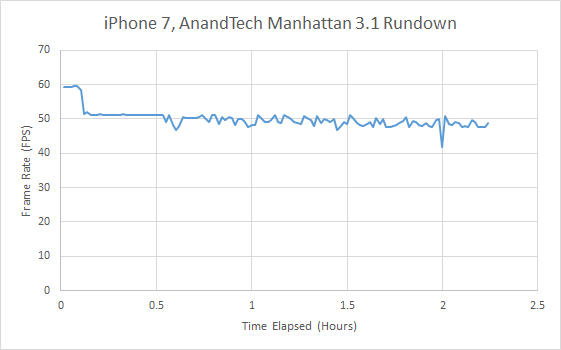
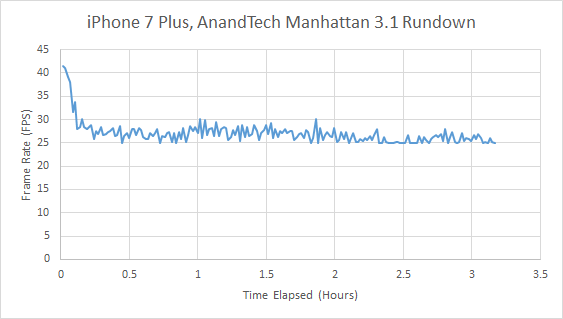
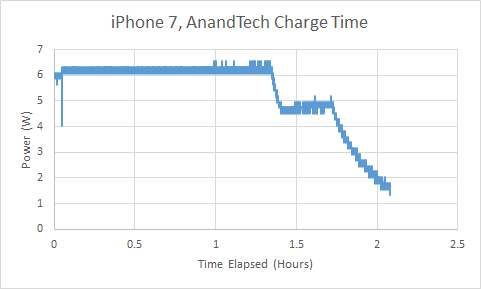
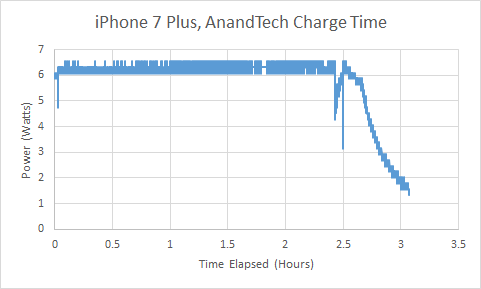








377 Comments
View All Comments
solipsism - Monday, October 10, 2016 - link
So you want legislation to artificially control smartphone prices and kill the free market. Brilliant¡If you graph the supply and demand for the iPhone you'll see that equilibrium price is actually lower than it could be. Meaning, Apple is actually losing money in the short term, but this isn't altruistic, but designed to help capture the market for the longterm, therefore increasing their overall profitshare. Economies of scale are already maxed out at it is.
The cost of components or what you perceive as the value of a smartphone is irrelevant—all that matters is what the market dictates. If you feel that high-end smartphones are too expensive, then don't buy them. They did release an iPhone SE because the market wanted a 4" model. If you and enough others stop buying smartphones in this price range you'll see that ARP drop. This happened in India.
jlabelle2 - Friday, October 14, 2016 - link
"They did release an iPhone SE because the market wanted a 4" model"Not at all. If it was the case, the sales of the iPhone 6 would not have been so huge compared to previous model.
The release the SE because they wanted to target people not willing to spend 750-850$ on a phone. The SE is selling mostly because it is half the price and the cheaper iPhone ever sold.
grayson_carr - Monday, October 10, 2016 - link
The price of iPhones has not risen. What are you talking about?grayson_carr - Monday, October 10, 2016 - link
The first iPhone was originally $599 subsidized with a two year contract, meaning over $1000 were it not for the subsidy, and the base model iPhone 3G was priced much lower at $599 full price without a contract, but that still equates to ~$670 today when you factor in inflation. So at a starting price of $649, the iPhone 7 is cheaper today than iPhones were 8 years ago accounting for inflation.StrangerGuy - Monday, October 10, 2016 - link
I didn't knew owning luxury goods is a fundamental human right.It doesn't matter much you stinkers try to hide your entitlement syndrome under the guise "for the greater good", you still get smelled a million miles away.
kogtsalami - Monday, October 10, 2016 - link
Small correction: The iPhone 4 was not made of aluminium but stainless steel.JoshHo - Tuesday, October 11, 2016 - link
The intent was to say that the iPhone 4 was one of the first smartphones to use external antennas integrated into the design rather than internal antennas embedded in RF windows.dsraa - Monday, October 10, 2016 - link
No mention of the audio performance through the new dongle? what about bluetooth sound?? I know this is a brief review, but at the very least their should be a section on audio and how it compares to the 6s since there it is now done through a digital 'adapter'???TechnologyGuy - Monday, October 10, 2016 - link
Sorry as usual with an iPhone review here - great on the details but illogical conclusions. The removal of 3.5mm headphone jack doesn't matter? That's a clear deal breaker for me, especially when AirPods for me literally belong in the garbage and having invested $1000's on headphones in the past. Not sure what you mean about the camera - iPhones have now barely caught up in quality, but clearly still lagging behind the S7 and Pixel. The iPhone 7 battery life is mediocore at best, and without fast charge or wireless charging - another automatic deal breaker for me. The screen is just passable in comparison to the competition.So really, the only thing that is industry-leading is the SoC, and I think at least for me, that hardly compensates for all the subpar areas. I am not sure why you are so obsessed with the SoC and system performance when the overall experience based on the components (at least those that matter in day-to-day usage - screen, camera, battery life/charging) is no batter than your average $300 phone. My experience with a phone does not depend how good I feel about the SoC under the hood. This phone is a clear no for me and not worth the $650-750 USD.
mrochester - Monday, October 10, 2016 - link
You're forgetting that you need to consider the OS and ecosystem too. A phone isn't just a bunch of hardware components, and it's an OS and software layer too, which is much more important than the hardware anyway.